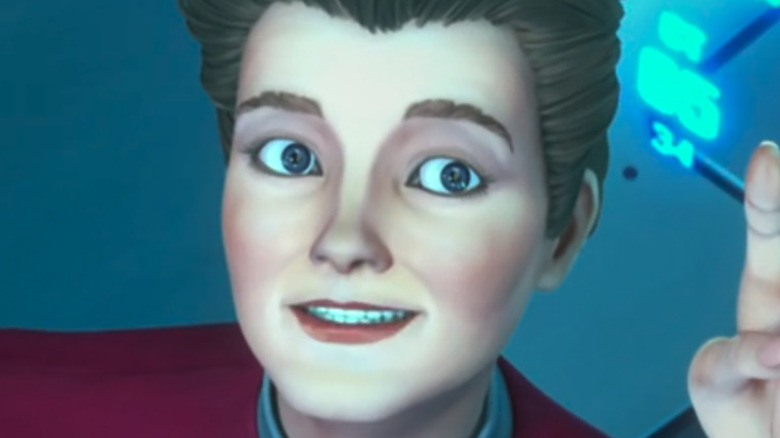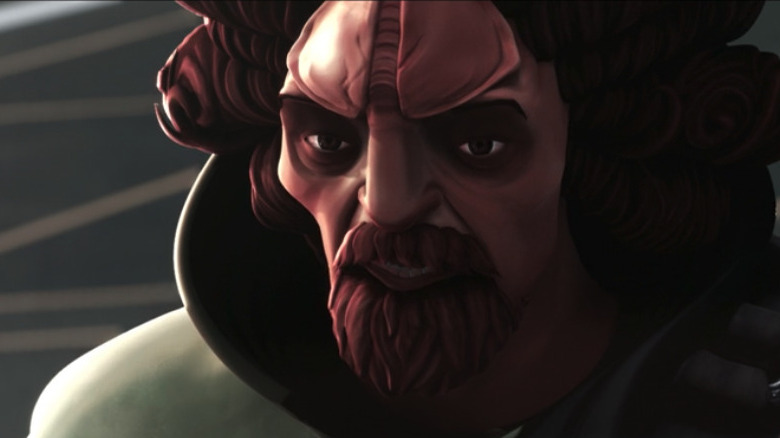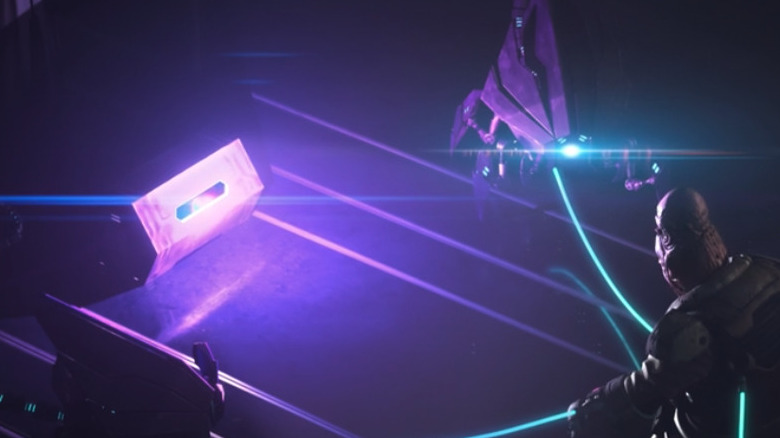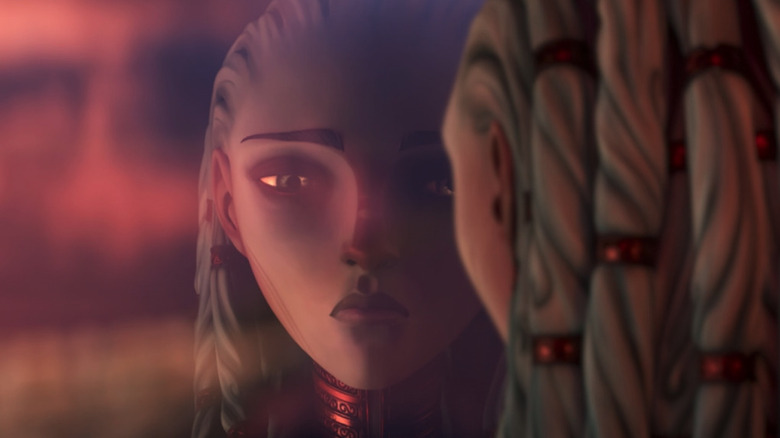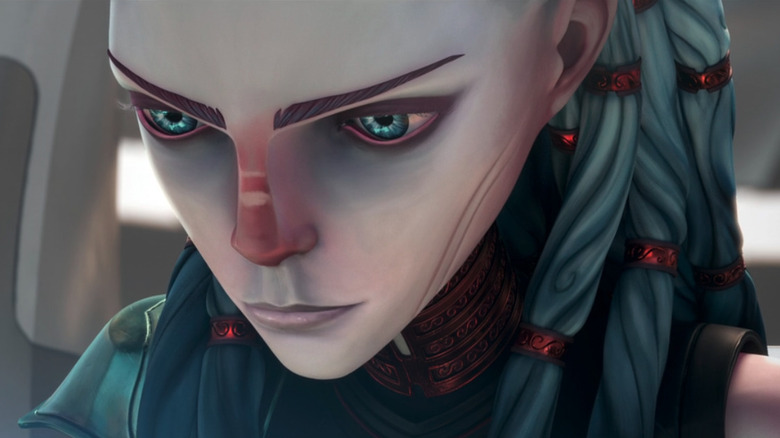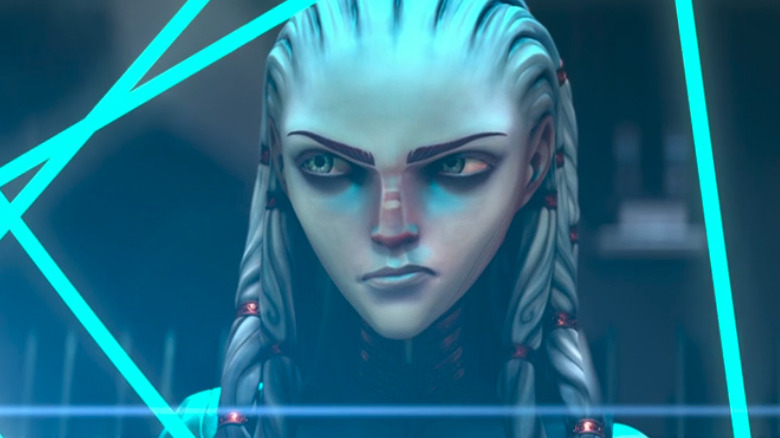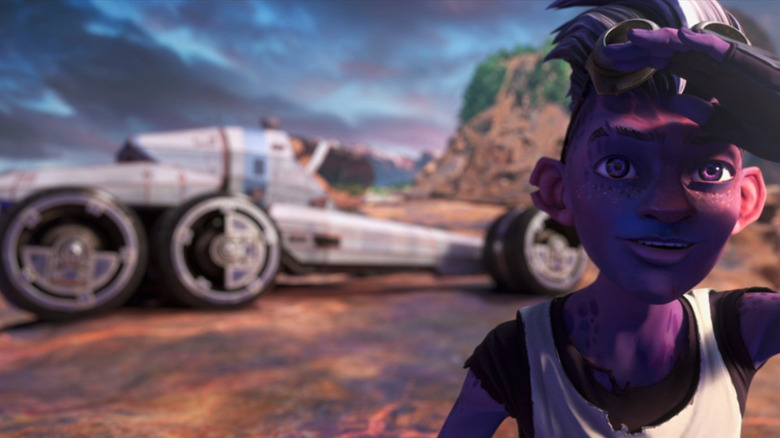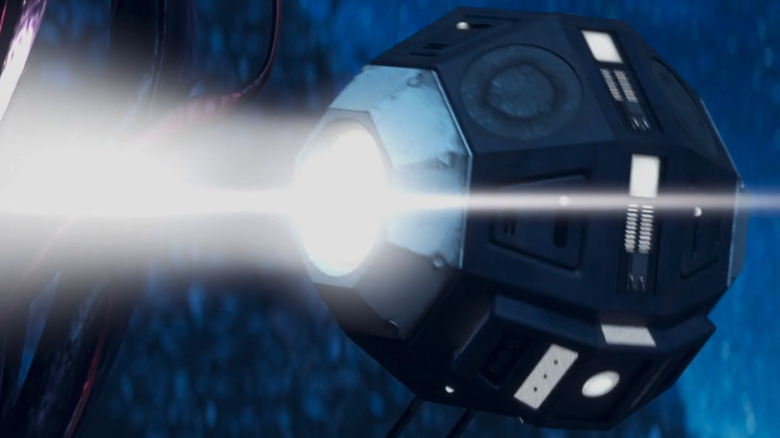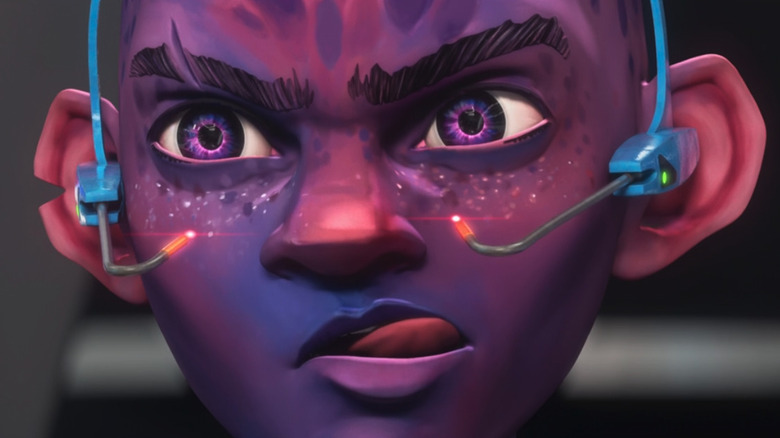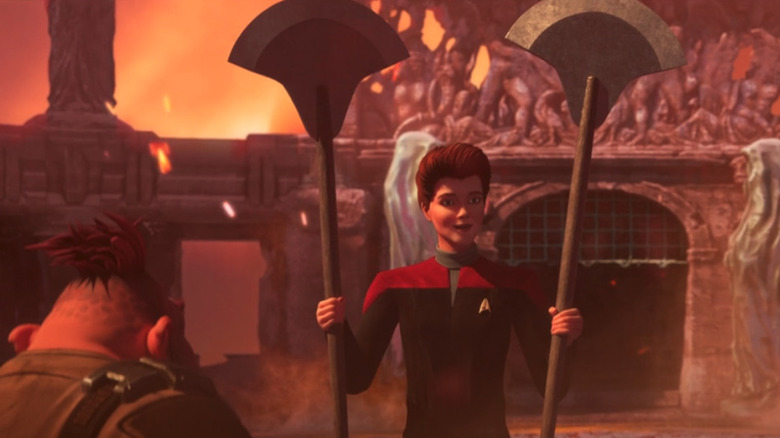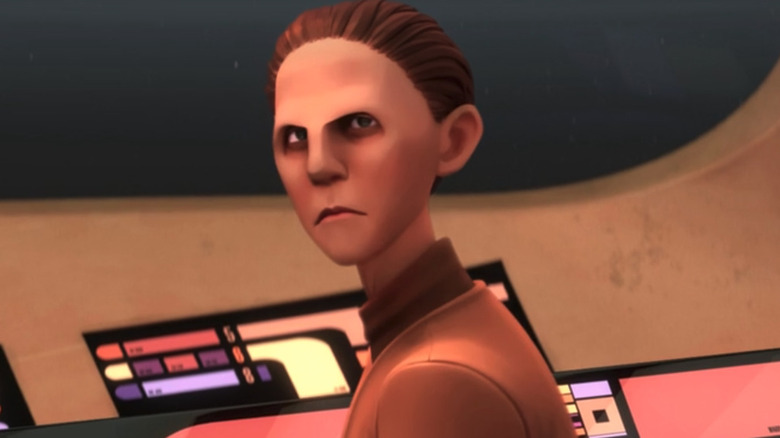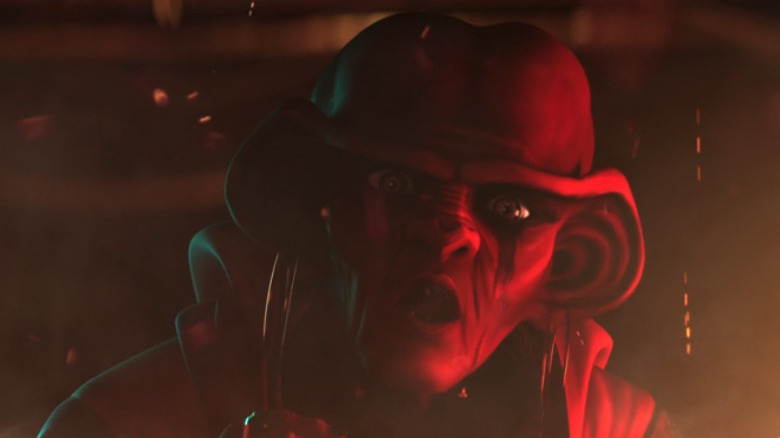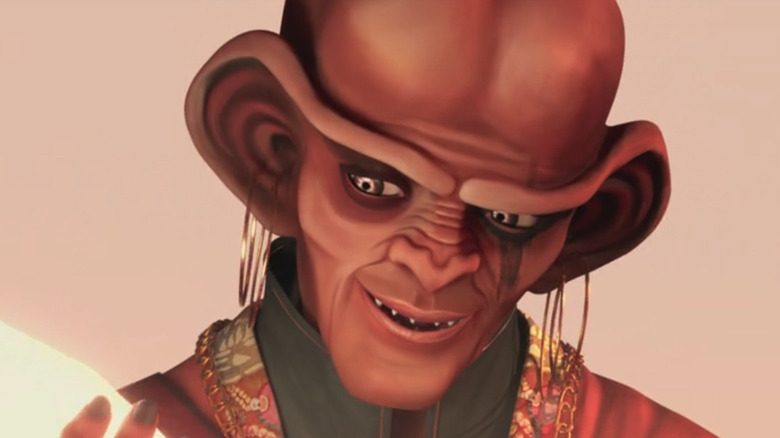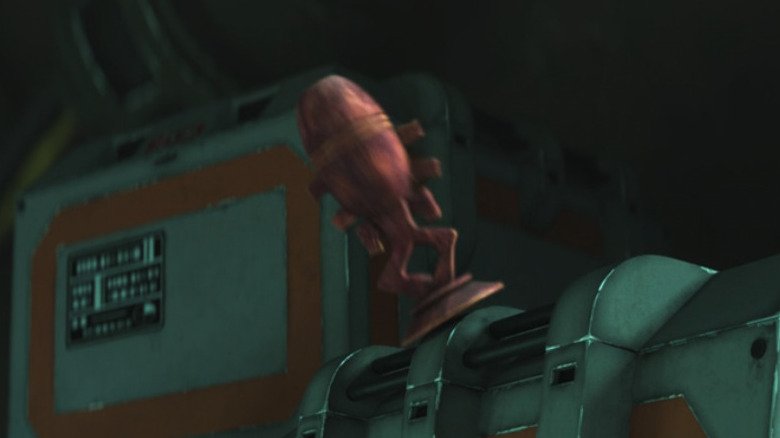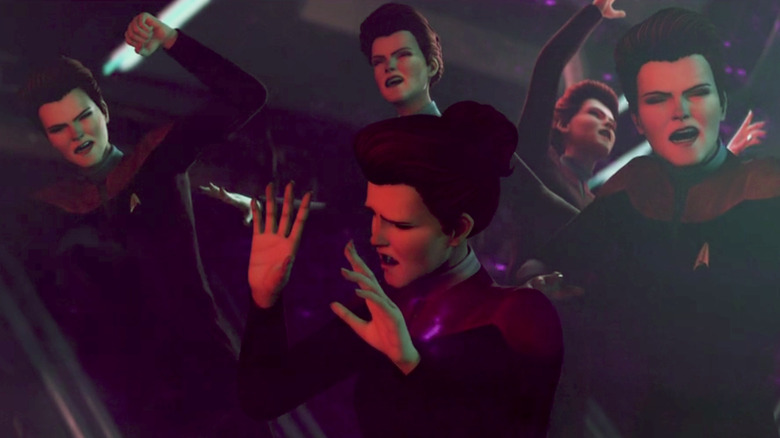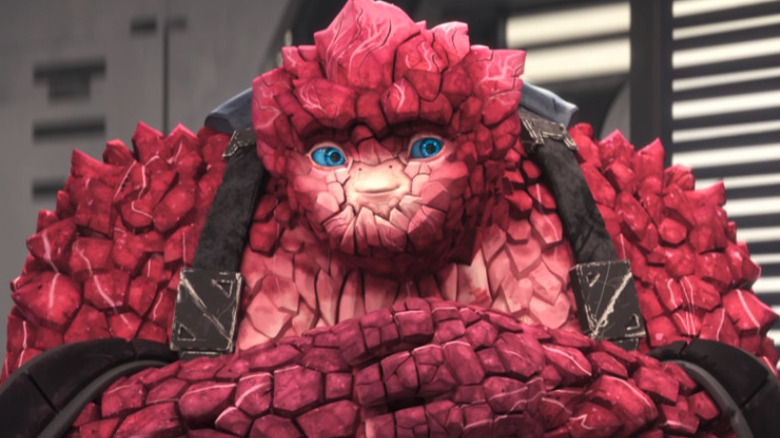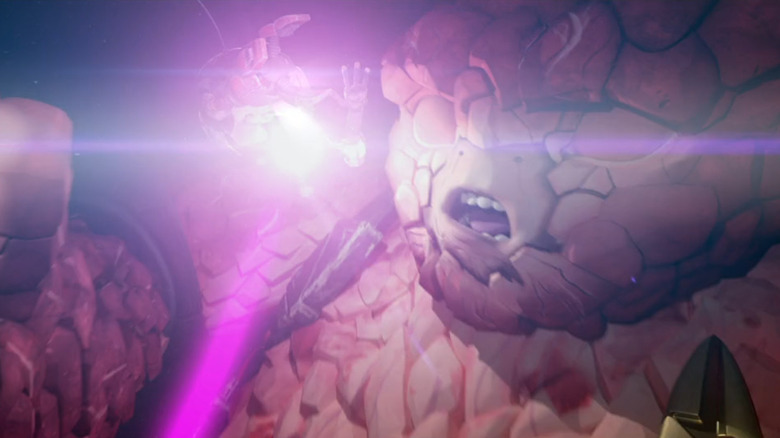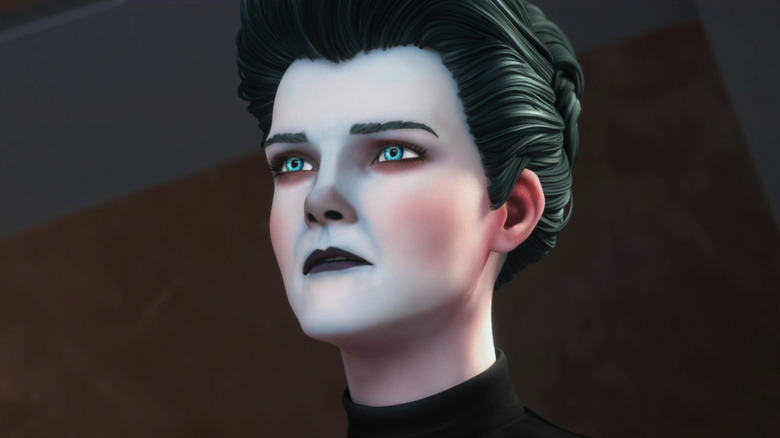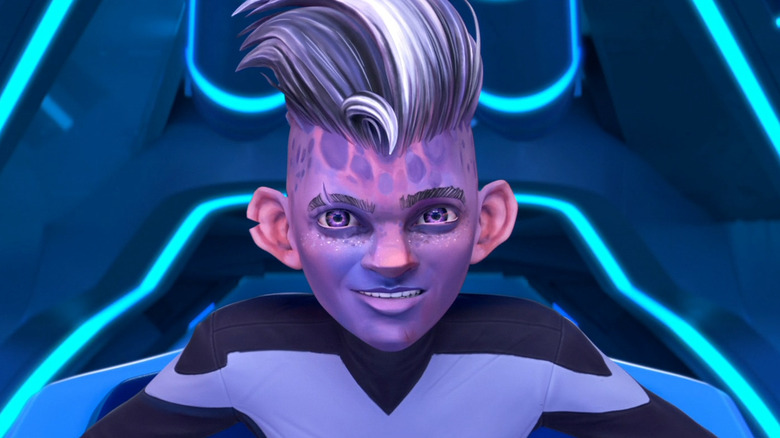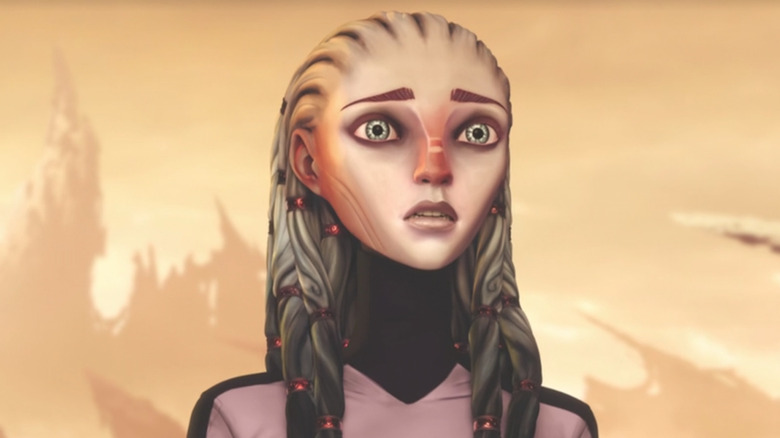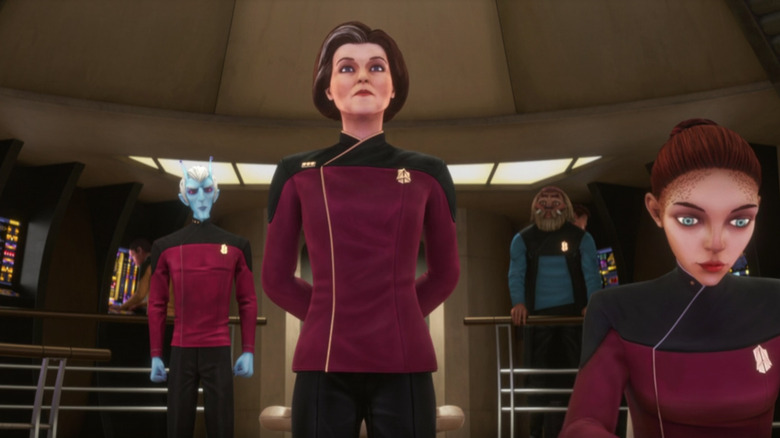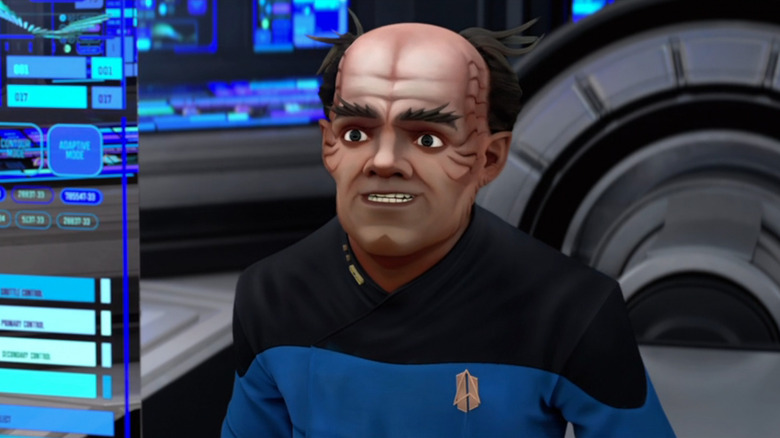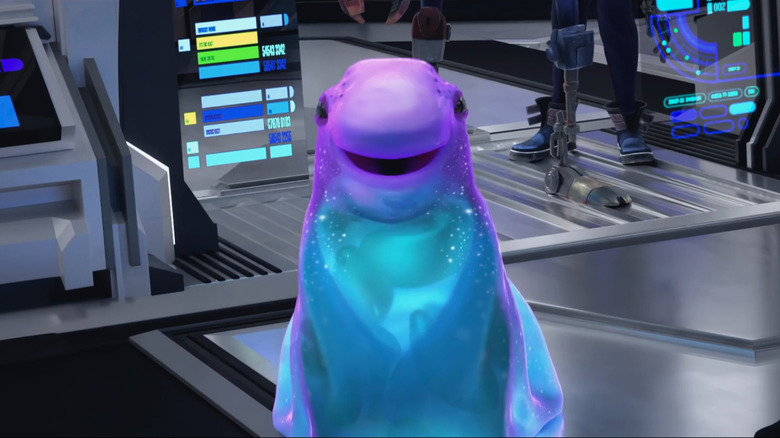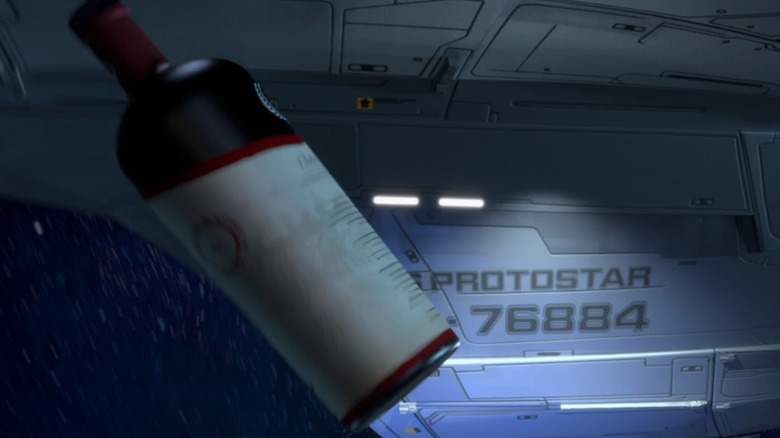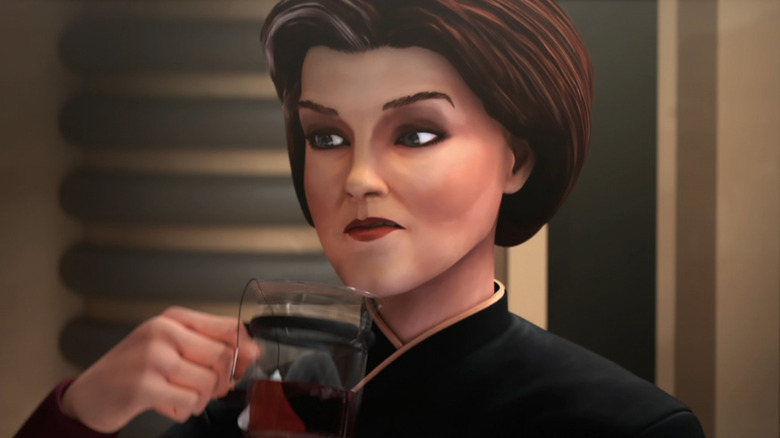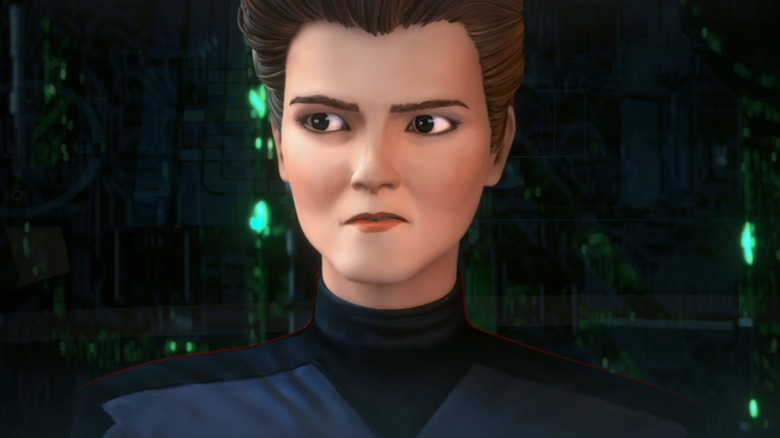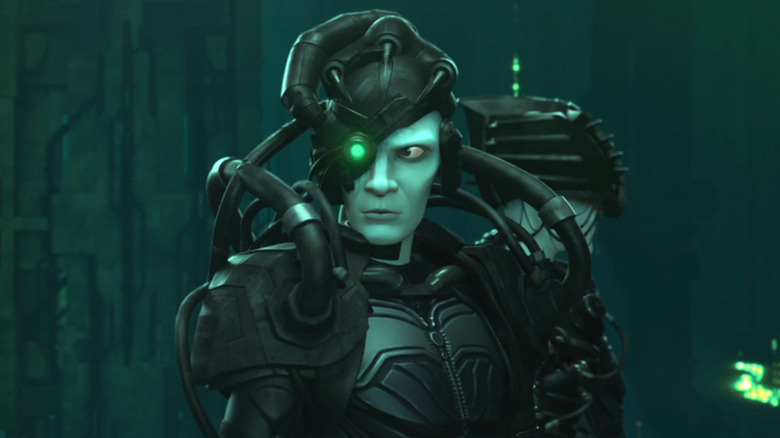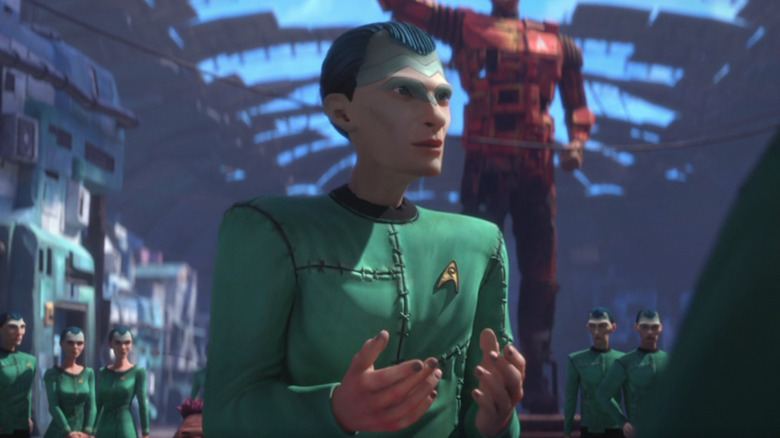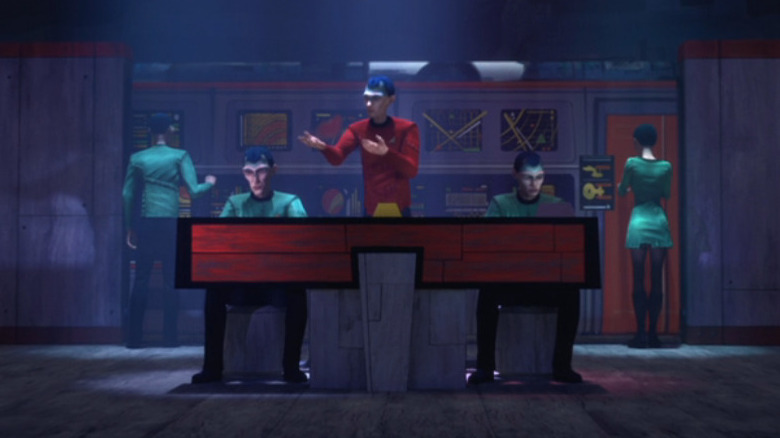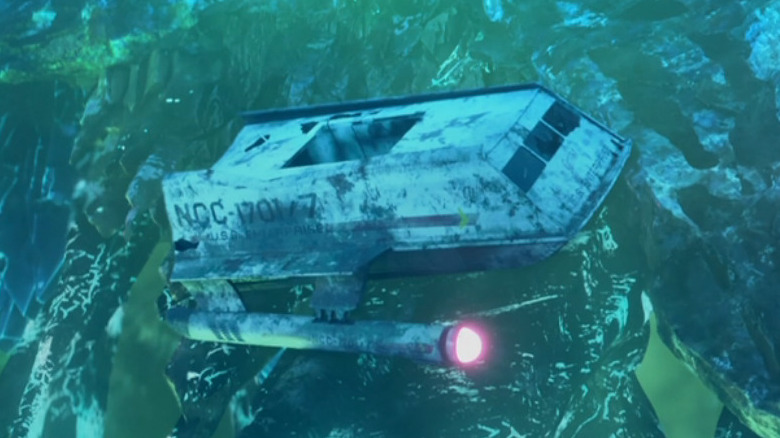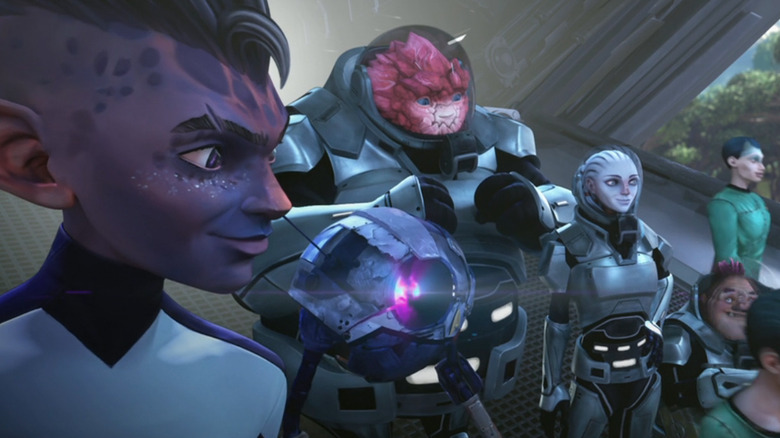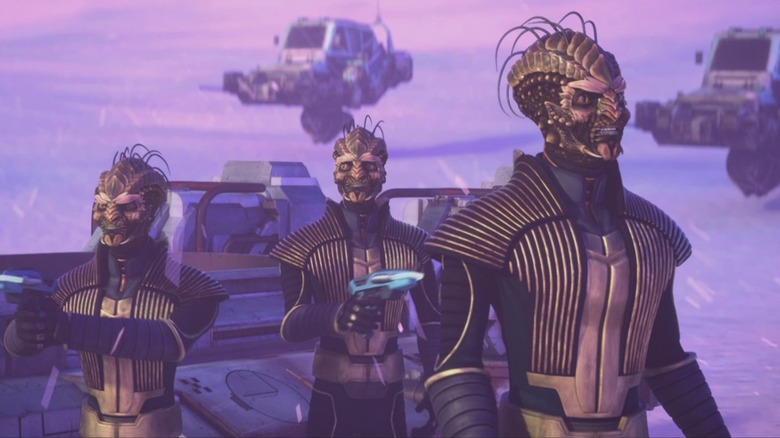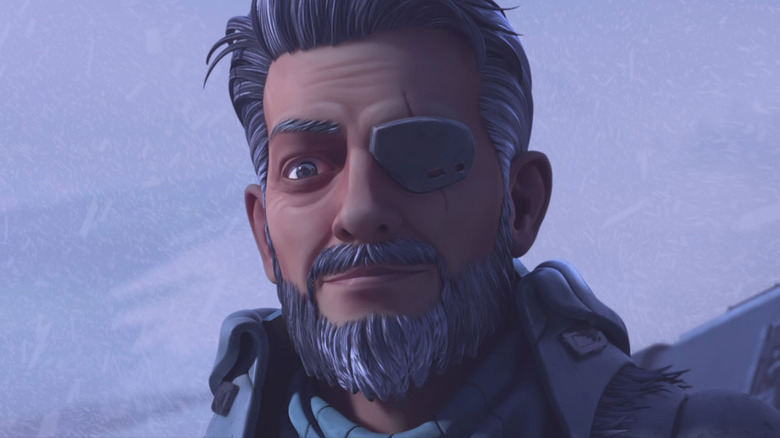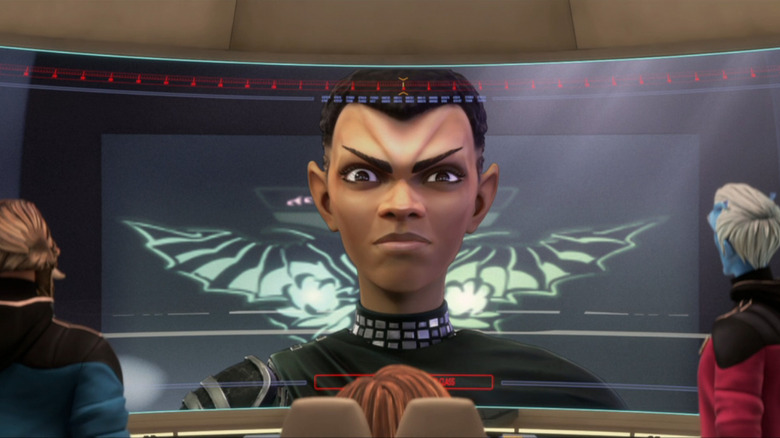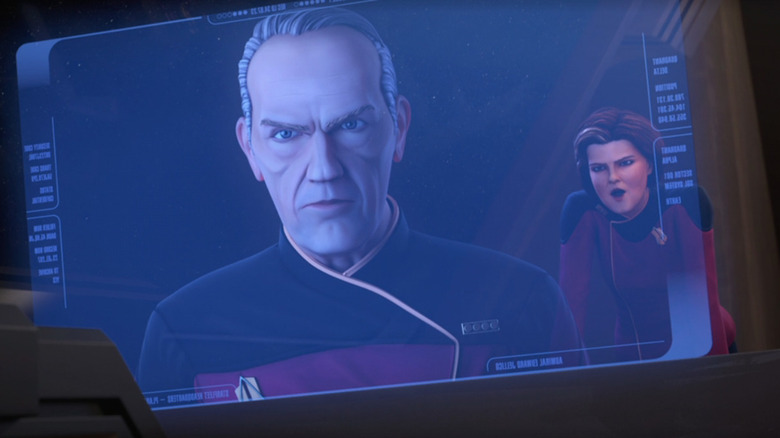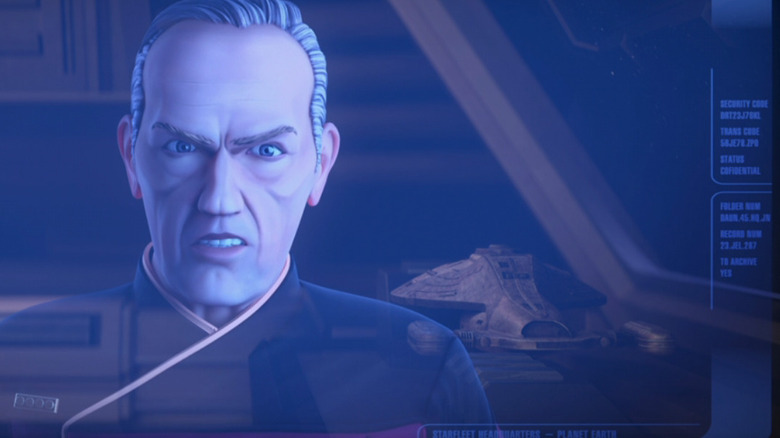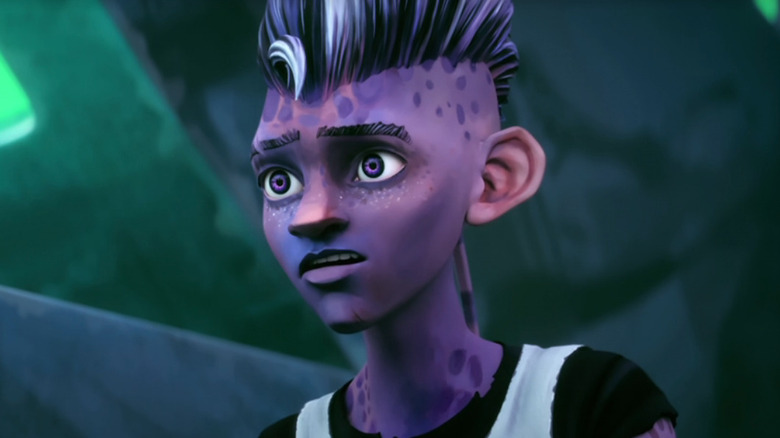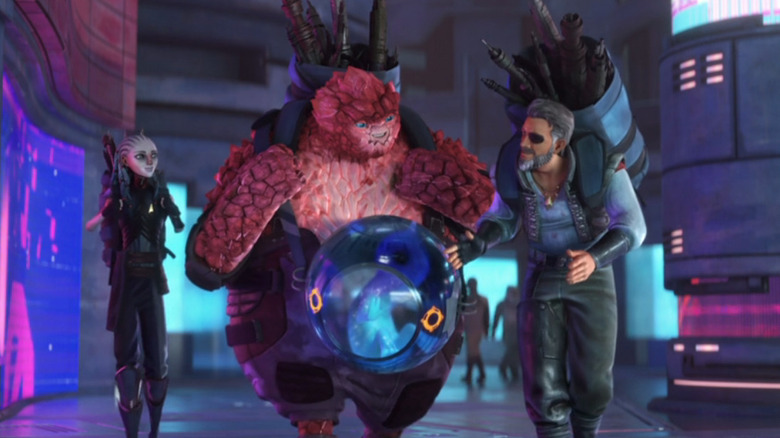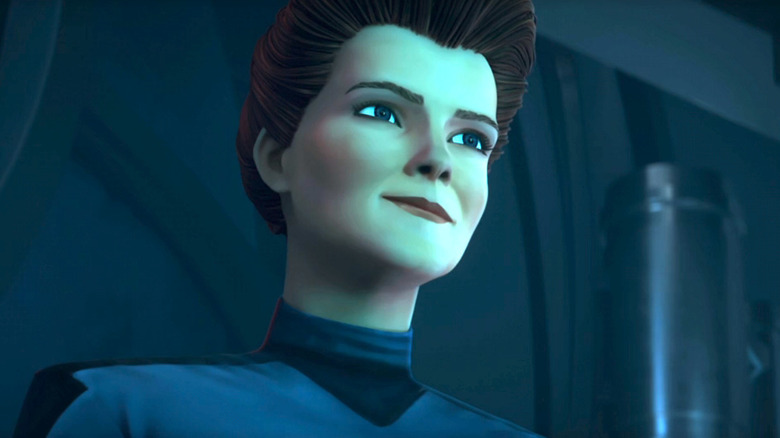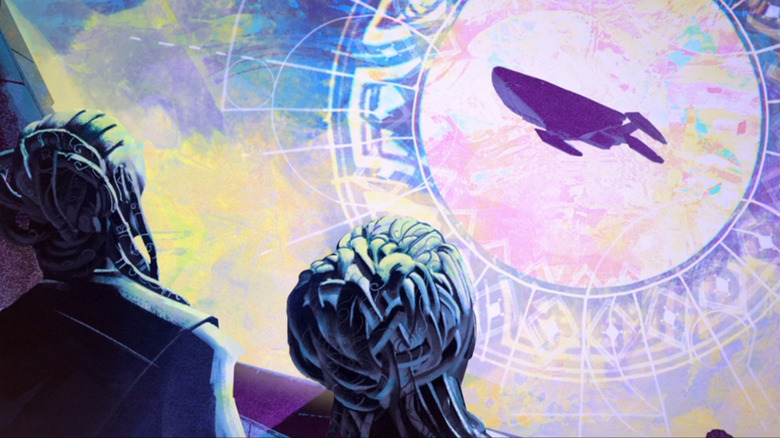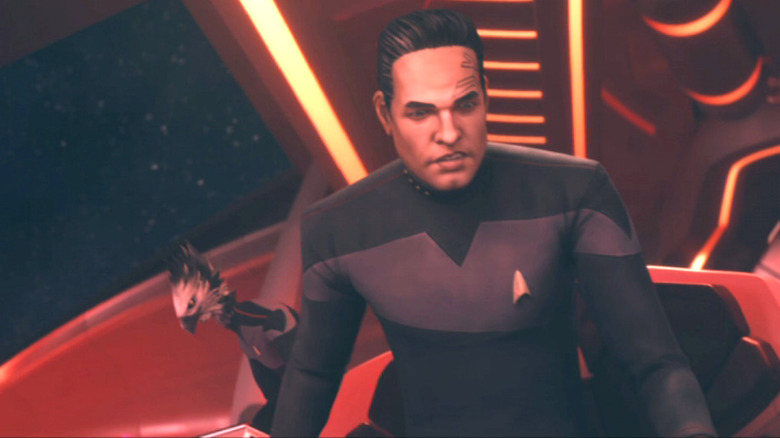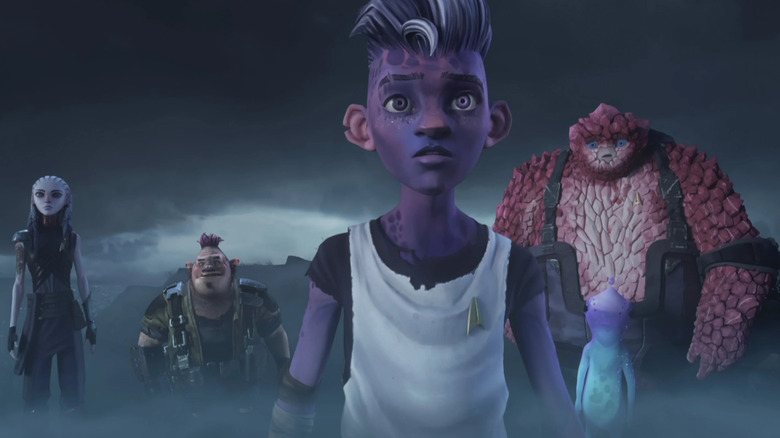Star Trek Easter Eggs You May Have Missed In Star Trek: Prodigy
"Star Trek: Prodigy" signals a new era for the iconic science fiction franchise as it boldly goes where it's (almost) never gone before: targeting kids, with a fun, fast-paced animated adventure. Save for two seasons of the painfully dull "Star Trek: The Animated Series" in the mid-1970s, it's the first time a "Trek" show has been aimed squarely at children, and this time it seems they've found the right mix of humor, strong storytelling, and importantly, high quality animation (something "TAS" lacked in spades). Focused on a group of rag-tag alien misfits on the edges of the far-flung Delta Quadrant who discover a crashed — and abandoned — Federation starship with mysterious origins, they escape their prison colony and set out on bold new adventures, all while being hunted by the sinister overlord called The Diviner.
Aided by a holographic program in the form of ex-"Star Trek: Voyager" star Captain Janeway (voiced by original actress Kate Mulgrew) in her long-awaited return to the series, the group finds the adventure they're looking for. But despite taking place far away from Federation territory, and holo-Janeway seemingly the only character with a connection to "Star Trek," the series is brimming with Easter eggs and references to past episodes and movies. Some are front and center and can't be missed, while some you may not have noticed. Here's a list of our favorites from the first season.
The Kazon return
In one of the premiere episode's darker moments — for a kids' show at least — we meet Drednok, one of the lead villains, and Gwyn, the daughter of the series' big bad The Diviner. They are meeting with a slave trader and freighter captain revealed to be the man who provides labor to the colony. Unfortunately, the captain has run out of escaped convicts and criminals, and is now selling orphaned children to The Diviner. But it's the captain himself that nets us our first Easter egg, as he's a Kazon, the race of gangster aliens that tormented the crew of the U.S.S. Voyager in the Delta Quadrant for its first three seasons.
Despite their many appearances on "Voyager" — a total of 15 across its first three years, as they acted as the primary antagonists on the series early on — this is also the first time we hear the Kazon language, as the captain speaks in his native tongue, with no universal translator present. It's also worth noting that the little orphaned child the Kazon provides for labor is a member of the species called the Caitian, the same feline race as Doctor T'Ana from "Star Trek: Lower Decks."
Zero's containment box
In the series premiere, "Lost and Found," the mysterious robot known only as "Fugitive Zero" tells her backstory to Rok-Tahk and Dal. In a brief flashback, Zero tells them how she was first brought to the slave world of Tars Lamor, and forced to do "terrible things" — in this case, torture prisoners and malcontents. Zero is a Medusan, a race of beings Trekkies haven't seen since the "Original Series" episode "Is There In Truth No Beauty?" Medusans are non-corporeal and exist as pure energy, with no physical form, and cannot be viewed by humanoid eyes lest the sight drive them mad. In the classic "TOS" episode, the Medusan Ambassador arrives aboard the Enterprise in a unique containment unit in the form of an angled box.
In Zero's flashback, when The Diviner and his Watcher droids use Zero to punish an upstart slave on Tars Lamor, Zero hasn't yet built his more sophisticated robotic body. In a clever callback, he's housed in a containment box that is a near perfect match for the one seen in the original "Star Trek" episode. In a double Easter egg, the alien that Zero is forced to torture is a Lurian, the same race as recurring character Morn on "Deep Space Nine."
The Window of Dreams
After both Gwyn and Dal are captured by the villainous Drednok, Gwyn is throw in detention and Dal is sent back to perform labor in the mines. While lamenting their situation, Gwyn asks Dal to retell her the story of a unique star cluster he'd once seen called The Window Of Dreams. He does so, and describes a site so incredible he failed to find the words for it, asking, "How do you describe the most beautiful thing you've ever seen?" This one is a pretty deep cut, going all the way back to an off-hand remark made by an alien starship captain in the "Star Trek: Voyager" episode "Body And Soul."
In that episode, the alien captain Ranek is courting Seven of Nine (who happens to be taken over by the Doctor's programming and personality, but that's a story for another time) and he briefly looks out the starship's viewport and points out the same star cluster to her. While flirting with Seven, he says of the cluster, "You could travel from one end of the quadrant to the other and not see anything like it," calling it "the most beautiful sight in the sector."
'Qu'vatlh!'
In the second "Prodigy" episode, titled "Starstruck," Gwyn is looking to escape the U.S.S. Protostar and calls up a schematic of the ship. Discovering a section of escape pods, she rushes off to locate them in the hopes of leaving the ship unnoticed. But when she gets to the escape pod bay, it happens to be in the same moment when "Captain" Dal is ordering the ship to dump non-essential materials, and the escape pods are quickly jettisoned as a result. Frustrated by her inability to access the pods, Gwyn exclaims, "Qu'vatlh!" as she pounds on the glass pane of the escape pod entrance.
Fans of "Star Trek" will recognize the Klingon curse "qu'vatlh" as the expletive spoken by General Martok on "Star Trek: Deep Space Nine," most notably in the episode "Sons and Daughters." In that episode, Worf's son Alexander comes aboard the IKS Rottaran and, despite having little training, attempts to become a Klingon warrior. When pressed about his motives, the young warrior is obstinate, and Martok likens his brusque nature to that of Alexander's father, noting that both he and Worf are "stubborn, tiresome qu'vatlh." How Gwyn knows Klingon curses despite being in the Delta Quadrant is not yet revealed.
The vehicle replicator
When Gwyn finds herself unable to access an escape pod in her attempt to leave the U.S.S. Protostar, the computer asks if she'd like to use the services of the "vehicle replicator." Up to this point in "Star Trek" lore, no such device has ever been referenced, and its inclusion here seems to be a response to common fan criticism of Janeway's U.S.S. Voyager, which inexplicably seemed to have an endless supply of shuttlecraft. Fans have long argued over the apparent inconsistency, such as in this Reddit post, which argues that the ship was constantly losing her shuttlecraft, either having them repeatedly destroyed, abandoned, or broken down for parts... and yet she always had more.
Though we've heard of "industrial replicators" that could produce large equipment, this new vehicle replicator (which acts more like a futuristic 3D printer than a simple matter materializer) could retroactively explain how Voyager was able to have a steady stream of long range shuttles. Either that, or it was the writer's way of taking a friendly jab at long-running fan theories and inconsistencies. Whatever the case, we no longer have to worry about Federation starships ever running low on shuttles.
The Argo's better-looking stepbrother
The two-part story in the episodes "Dreamcatcher" and "Terror Firma" begins with a few fun Easter eggs. In the first half, holo-Janeway urges the crew to explore a newly discovered M-Class world, following Starfleet's mission to seek out new life and new civilizations. The crew excitedly go along, happy to get off the ship and hoping for a respite from their travels.
While exploring the new uncharted planet, Jankom discovers a derelict Klingon Bird of Prey, the same kind seen frequently throughout the classic "Star Trek" films and "Star Trek: The Next Generation." Meanwhile Dal takes a joyride in a Starfleet dune buggy of sorts taken from the Protostar. We've only seen such a Starfleet vehicle once before, in the much-maligned "Star Trek: Nemesis," with the Argo piloted by Captain Picard. It seems the Enterprise-E may not be the only Starfleet ship equipped with one. Then again, with a vehicle replicator, Dal may have just created one to go exploring.
Exocomps return
"Terror Firma" picks up right where "Dreamcatcher" left off, with the ragtag crew trapped on a violent alien world using their own dreams and nightmares against them. Stuck alone aboard the Protostar, the holographic program of Captain Janeway does what she can to help, but first she's got to get the ship back in working condition. Entangled in nasty vines, she orders "photonic scrubbers" to clean up the ship. At her command, a series of pod-like droids scurry out of the ship and begin using energy beams to clean off the vines. You might think this sequence has a bit more of a "Star Wars" look to it, but the droids themselves have some precedent, as they appear to be modified versions of the exocomps seen in the "Next Generation" episode "The Quality of Life."
In that original episode, an alien scientist has created the exocomps to be advanced, artificially intelligent drones that can perform dangerous work that might endanger humanoid workers. Data of course discovers that the exocomps might be sentient, and sets about to prove it, in the hopes of ending their forced servitude. If these are indeed exocomps in "Terror Firma," the noticeable differences could suggest they've been stripped of their sentience, allowing them to be the original AI tools they were invented to be.
Playing the game
"Kobayashi" is absolutely jam-packed with great references for Trekkies, culminating with an appearance by Voyager's first officer, Chakotay (voiced by original actor Robert Beltran). As the episode opens, the ship is cruising through space while the crew is still trying to figure out exactly how its newly discovered "Protostar Drive" works. Even holo-Janeway seems mystified, but when we cut to Dal in his ready room, he's engaged in a harmless bit of recreation. From a POV perspective, we see Dal is playing a game first seen in the "TNG" episode appropriately titled "The Game." It's a device that fits around the temples and projects a virtual disc-throwing game into the wearer's eyes. In the original 1990 episode, it was used by a villainous criminal Ktarian to brainwash the crew of the Enterprise in the hopes of conquering the Federation.
Here, it seems to have no such ill effects as Dal casually tosses it off his head when interrupted by Zero, Jankom, and Rok-Tahk. Why the U.S.S. Protostar would have a version of this device — even a non-brainwashing version — is a mystery, but perhaps the game itself was used in a more innocent way before the Ktarians deployed it to attempt their hostile takeover of the Federation.
Holodeck programs on the Protostar
When Dal and Jankom Pog discover the Protostar's holodecks, holo-Janeway runs them through some of the possible programs the room can create for them. Several of the holodeck programs mentioned by holo-Janeway have been seen before, and are clear references to previous "Star Trek" episodes and movies from its long history. The program focused on skydiving on Ceti-Alpha V is a clear nod to the planet that Khan was exiled to in "Star Trek II: The Wrath of Khan" — and possibly a reference to the "Star Trek: Voyager" episode "Extreme Risk," which involved B'Elanna going orbital skydiving.
After Jankom and Dal fall through the clouds, she conjures a kal-if-fee match on Vulcan — the gladiatorial combat between Spock and Kirk in the classic "TOS" episode "Amok Time" — complete with the original series' iconic fight music. She suggests a Jane Eyre holo-novel, similar to the program the real Janeway enjoyed on "Voyager," and notes it as a personal favorite. Before Dal settles on trying out the Kobayashi Maru scenario, he scrolls through a menu that also mentions an adventure in Deadwood (a reference to the "TNG" episode "A Fistful of Datas") and Paxau Resort (one of Neelix's favorites).
Kobayashi clips
The episode "Kobayashi Maru" had the Protostar's misfit crew undergoing a famed training exercise, and the holodeck puts them on the bridge of the Enterprise-D, which we get a look at for the first time since the finale of "Star Trek: Enterprise." Dal populates the scenario with characters from throughout Trek's past: Spock, Uhura, Dr. Crusher, Odo, and Scotty. While Crusher's dialog is newly recorded by Gates McFadden, the others all speak through archival audio from old "Star Trek" episodes, allowing three deceased actors — Leonard Nimoy, Rene Auberjonois, and James Doohan — to return to life.
Trekkie YouTube channel "Ryan Edits" compiled every source for the archived audio, revealing Spock's lines were taken from the episodes "Balance of Terror," "The Immunity Syndrome," "The Enterprise Incident," "The Ultimate Computer," "Journey To Babel," "The Doomsday Machine," and "The Changeling." His final speech includes clips from the episodes "Obsession" and "The Enemy Within," the film "The Wrath of Khan," the "TNG" episode "Unification," and his appearance in J.J. Abrams' "Star Trek" film.
Uhura, meanwhile, was given dialogue from "The Wrath of Khan" and the episodes "The Gamesters of Triskelion," "The Enterprise Incident," "Balance Of Terror," "The Mark of Gideon," "Space Seed," and "The Trouble with Tribbles." Odo's audio was lifted from the "DS9" finale, along with the episodes "Fascination," "Shadowplay," "Heart of Stone" "The Way of the Warrior," "A Call to Arms," and "Things Past." Oddly, most of Scotty's dialogue was from "The Next Generation" episode "Relics," with one short clip from the "TOS" episode "The Doomsday Machine." Lastly, even the Kobayashi's distress signal was directly pulled from "The Wrath of Khan."
The Phage
After a hilarious opening gag where the young crew discovers, and experiments with, the ship's transporters — having never seen any device like it before — they answer a distress call from a mysterious woman who needs their help. Her face hidden under a cloak, she holds what appears to be an alien baby in her arms as she cries out for help, insisting she needs immediate transport because she has sick orphans that need assistance. But Dal isn't fooled by the obvious ruse and seems to know what's going on. Approaching the viewscreen, Dal asks, "Let me guess, your sick orphans have a bad case of the Phage?"
As it turns out, this is no woman in distress, but Dal's old mentor, Nandi, who also happens to be a Ferengi. "The Phage" may jog the memory of longtime "Trek" fans, particularly those who've watched "Star Trek: Voyager." In the early years of the series, one of their primary foes was a race called the Vidiians, who would steal organs from healthy living humanoids to help them battle a life-threatening disease called the Phage that destroyed their bodies. Though it was cured by a group called "The Think Tank," it's clearly now used by con artists to lure in their marks.
The Rules of Acquisition
Once it's revealed that the mysterious "damsel in distress" is actually Dal's old mentor Nandi, the crew of the Protostar goes to meet her, with Dal excited for a family reunion. We see the classic Ferengi starship first introduced in the "Next Generation" episode "The Last Outpost" and not seen since the "Star Trek: Voyager" 7th season episode "Inside Man." In Nandi's cargo bay, the crew finds a Klingon cloaking device which becomes a focus of the episode, as Dal and crew want to trade for it to help them stay off The Diviner's radar. But we've seen this device before, in the "Deep Space Nine" episode "The Emperor's New Cloak," which ironically was a Ferengi-focused episode.
The best Easter eggs come when Nandi and Dal begin to quote from the Rules of Acquisition, the Ferengi precepts that govern their society and are often quoted in "Star Trek" spinoffs. Dal seems intimately familiar with them, so clearly his upbringing with Nandi had him memorize them, as he mentions Rule of Acquisition #208 ("Sometimes the only thing more dangerous than a question is an answer," first mentioned in the "DS9" episode "Ferengi Love Songs"). Nandi later quotes Rule #21 ("Never place a friendship above profit," from the "DS9" episode "Rules of Acquisition") and of course, Rule #1: "Once you have their money, you never give it back."
Hor'gahn
After Nandi's plan to fleece an alien race of precious crystals is foiled by a clever Dal, she returns to her ship understandably angry. Sitting in her ship's cargo bay, Nandi shows her annoyance by tossing an item across the room in a fit of rage. Eagle-eyed viewers may have noticed something familiar about the unfortunate relic that Nandi uses to take out her frustration, as it flies across the cargo bay, bangs into a shipping container, and falls to the floor. A quick pause will reveal the item is none other than a hor'gahn, a fertility idol from the pleasure planet Risa, possession of which indicates that one is seeking "jamaharon."
Though we're never told quite what jamaharon is, it's implied that it's an adult activity decidedly not for children, making the inclusion of the hor'gahn a bit suspect in a kids' cartoon. Nevertheless, the idol — first seen in the "TNG" episode "Captain's Holiday," which is by no coincidence a Ferengi-centric episode — is clearly visible to fans in the know. Diehards may also have recognized some other bits from "Star Trek" lore in this episode, including Nandi's love of the tube grubs, her Klingon disrupter pistol, and her mention of losing her money on the popular casino game called Dabo.
A classic Trek temporal anomaly
There's been much debate over the last decade as to whether more recent "Star Trek" shows and movies are "real" "Star Trek," with many fans feeling they depart from past formulas. But somehow, "Star Trek: Prodigy" has proven itself as true to the ideals and tropes of classic "Trek" as any, and there has been little debate as to its "Trekness." It proves it once again in "Time Amok," an episode whose title pays homage to the "Original Series" episode "Amok Time" and draws concepts from a number of past franchise tales. It's also the first episode of "Prodigy" to give an official stardate.
When the episode begins, the Protostar comes into contact with a space anomaly that fractures the ship in time. As result, each member of the crew is trapped in a different part of the ship existing in a different temporal phase. Holo-Janeway finds a way to help them communicate back and forth, but when the anomaly causes the ship's engine to overload and destroy the ship in one of the time phases, they must find a way to work together to go back and stop it from happening. The concept of the ship being repeatedly destroyed due to a time travel mix-up, and the crew trying to stop it from happening again and again, was seen in the memorable "Next Generation" episode "Cause & Effect." Meanwhile, fans of "Star Trek: Voyager" will note the ship fractured in time being awfully similar to the episode "Shattered."
Rok-Tahk's hard time
To solve the temporal problem in "Time Amok," each member of the Protostar's upstart crew must help build a new warp matrix. Holo-Janeway helps, but it's up to the kids to actually build it and install it. Unfortunately, none have the expertise or know-how to do it on their own, but together — working across time — they may have a chance. It's a great lesson in teamwork, but in the final moments, the last member of the crew, Rok-Tahk, can't do it.
Thankfully, Rok-Tahk exists in the slowest time period, and spends years there learning how to accomplish the task. She claims to have spent the time learning quantum science and computer engineering, and teaches herself the skills she needs to do the job. Janeway and Gwyn privately discuss the great amount of time that Rok-Tahk spent alone, clearly concerned for her well-being. Whether this is an Easter egg or a reference, it clearly recalls the "Deep Space Nine" episode "Hard Time" in which Chief O'Brien spends decades in isolation in a virtual prison, and emerges a traumatized man. It remains to be seen if Rok-Tahk will suffer any long-term effects — though given that it's a kids cartoon, it's unlikely– but it's a new and clever use of the same idea.
Anomaly effect
Halfway through the episode "Time Amok," the crew is still struggling with the effects of the spatial anomaly. Holo-Janeway is having trouble convincing the crew of what's happening to them and how they'll have to work together through different time phases to solve the problem. Zero is having the easiest time understanding the problem and helping Holo-Janeway to fix it, but when the rushed time phase collapses, she's once again thrust into a different part of the ship. To serious Trekkies, the effect used to show the move to a new time phase should look awfully familiar.
At the moment when Holo-Janeway is pushed out of phase, we are treated to an abstract visual montage of all of the main characters floating in space, frozen in time, as the "camera" moves past each of them in an arch. This is similar — and a clear reference — to the time travel effect used in "Star Trek IV: The Voyage Home" when Kirk, Spock, and the rest of the Enterprise crew slingshot around the sun to travel back in time to the present day of 1986. There, the computer-generated recreations of the crew floated past the camera in an eerie effect that was a cutting edge use of CGI in its day and one of the earliest examples of 3D morphing in a major motion picture.
Corrupted Janeway
In the first part of "A Moral Star," The Diviner tells the crew that if they return to Tars Lamora and give him the Protostar, he'll free the laborers he has enslaved in his mining colony. Conflicted over whether they should help the enslaved people while empowering their enemy, they ultimately decide to engage in a risky plan that will both save the miners and keep the ship. Holo-Janeway says that taking on an impossible mission to save others and bring hope to a hopeless cause is the most Starfleet thing they could ever do. Little do we know it's the last time we'll see our normal Holo-Janeway in the episode.
When they arrive at The Diviner's world, the villain changes the terms of their deal and takes Gwyn aboard the Protostar. Once there, he reprograms Holo-Janeway into an "evil" version of her former self (noted in the credits as "Corrupted Janeway"). Her new all-black uniform and cold personality feel like a reference to the "Star Trek: Voyager" episode "Living Witness," where a future society envisions Voyager as a sinister warship and Janeway as a calculating, black-clad captain. Reprogramming the holo-assistant to turn them evil has been done before, too, in the "Voyager" episode "Equinox," when the Doctor has his ethical subroutines gutted to turn him into a vicious surgeon. Whether these are intentional references or mere coincidence, it's nice to see "Prodigy" playing with classic "Star Trek" tropes like evil alternate versions of its main cast.
'Go fast!'
With their plan in place, the young crew of the U.S.S. Protostar prepares to jump to the Diviner's colony world, Tars Lamora. They enter the bridge in snazzy new Starfleet uniforms — which Holo-Janeway wholeheartedly endorses, even reprogramming her visual matrix to match — and set a course. When the ship reaches Warp 9.7, Captain Dal tells his crew to ready the ship's advanced proto-drive, and as they respond with all hands ready, he gives the order: "Go fast!"
The ship accelerates to speeds that Captain Janeway's U.S.S. Voyager can only dream of, and fans will surely recognize Dal's order as his new command catchphrase. The tradition was popularized in "Star Trek: The Next Generation" when Captain Picard made the phrase "Make it so" a pop-culture catchphrase, and it continued in the J.J. Abrams movies with Captain Pike's "Punch it." Elsewhere, the same character on "Star Trek: Discovery" used a slightly altered "Hit it!" The young Dal seems to have finally accepted his role as captain in "A Moral Star, Part 1" as he confidently takes the center chair for the first time. The introduction of his own catchphrase command order is a nice touch to cement him as the true leader he is destined to be on the series.
First contact gone wrong
In "A Moral Star, Part 2" the Diviner finally reveals the secrets he's been keeping all season: his past with Gwyn, his vengeful hatred for the Federation, and his reason for wanting the Protostar so badly. When the episode opens, he's now in command of the U.S.S. Protostar. However, Gwyn's failsafe meant that Holo-Janeway wasn't corrupted after all and easily overpowers The Diviner. He then pleads with his progeny to let him complete their mission to save their homeworld.
The Diviner claims that he's actually from a future where their homeworld has been ravaged by a war sparked by first contact with Starfleet and has come back in time to stop it. After first contact, their people fight over whether to join the Federation or remain isolationists, and it sparks a devastating civil war that destroys their world.
The possibility of a newly discovered world being brought to the brink of war over first contact has been mentioned before, specifically in the appropriately titled "The Next Generation" episode, "First Contact." In that episode, the Enterprise arrives on the planet Malcor III just as they develop warp drive technology. The crew meets a government bureaucrat who represents the world's more hard-line conservative elements and fears that if they have relations with Starfleet, it will spark just such a civil war. Now, on "Star Trek: Prodigy," we see just how devastating a first contact can be and the effects it can have on a fractured people.
The U.S.S. Dauntless
As "The Moral Star, Part 2" comes to a close, the crew stops the Diviner and rescues the unwanted from Tars Lamora. The scene then cuts to a different Starfleet ship that has detected the Protostar's power signature. The bridge is full of easter eggs, including the crew's combadges that mirror the ones seen in alternate future timeline episodes like "Voyager" finale "Endgame." However, the biggest reveal is that the ship's leader is none other than the real Admiral Janeway, commanding the U.S.S. Dauntless, which is a ship Trek fans should be familiar with.
The Dauntless appeared in the "Voyager" episode "Hope and Fear," but what makes its reappearance odd is that the Dauntless isn't a Starfleet vessel. In the episode, the crew of the Voyager encounters a man named Arturis, who helps them decipher a Federation message that leads them to the Dauntless, supposedly a new Starfleet ship. However, it turns out to be an elaborate ruse by Arturis to lure them into a trap. Despite previously being a deception, the ship's appearance on "Prodigy" resembles its Starfleet facade in "Hope and Fear," with its bridge design specifically being a near match, making it a curious inclusion.
Is this the same alien ship repurposed by the Federation, or a new Starfleet vessel designed to mimic the one we saw before? Thematically its appearance makes sense, as the Dauntless was, like the U.S.S. Prodigy, intended as a ship with an experimental engine. Hopefully, we'll get some answers when we see more of it in future episodes.
Nobody likes Nimbus III
The second half of "Star Trek: Prodigy" Season 1 begins with "Asylum." The kid crew of the U.S.S. Protostar has finally reached the edges of Federation space, but the fact that they've technically stolen the vessel makes them nervous as they approach a Federation relay station. However, the man they find there is a Denobulan named Barniss Frex, and when he arrives on screen we get a couple of immediate callbacks. For starters, he's the first member of his race we've seen since Dr. Phlox, the ship's doctor on "Star Trek: Enterprise." Additionally, his uniform appears to include rank insignia that matches the Maquis crew member's provisional rank insignias from "Star Trek: Voyager."
Still, the best Easter egg comes when he briefly believes that the Protostar has arrived to transfer him to a new location. He fears he'll be sent to Nimbus III, the only place he could imagine worse than his current assignment. He's not wrong, as the world was located in the Neutral Zone. Seen in "Star Trek V: The Final Frontier," it was nicknamed the Planet of Galactic Peace owed to the fact that members from several rival races — including Klingons, Humans, and Romulans — all lived there in relative harmony.
Mellanoid Slime Worm revealed
Once matters have settled with Frix, the kids need to be checked into the Federation database, which leads to a handful of species references. While scanning Dal, Frix name-checks a pair of Delta Quadrant races seen in "Star Trek: Voyager." This includes the Sakari, a race of people who lived in a world that had been all but destroyed by the Borg. They had been forced to live underground, as seen in the "Voyager" episode "Blood Fever." Frix also suspects Dal could be a Talaxian, likely due to his skin spots and frazzled hair, traits shared by Neelix, the most famous Talaxian on "Voyager." Frix is wrong on both counts, though we never learn exactly what species Dal is — an important part of the show's ongoing mystery.
When Frix gets to Murf, the strange amorphous slug, we're treated to arguably the episode's biggest deep cut. Murf's species has been largely a mystery to this point, but we finally know that he's a Mellanoid Slime Worm, and that's not new to "Star Trek." In fact, it was used as a derogatory slur all the way back in a Season 1 episode of "Star Trek: The Next Generation," when a Zaldan named Rodon hurled the insult at Wesley Crusher.
The official wine of Starfleet
At the end of the mid-season finale, "A Moral Star, Part 2," viewers are teased with the appearance of the real Janeway, who is now an admiral. She is on the hunt for the Protostar, which was revealed to be captained by her former first officer, Commander Chakotay. In "Asylum" we see a flashback to the launch of that mission, where Chakotay is put in command, and the Protostar is christened. In keeping with an old naval tradition, first shown in the 1994 film "Star Trek Generations," a bottle of wine is hurled into the side of the Protostar's hull, smashing to pieces, in a clear callback.
In addition, in a blink-and-miss-it moment, we see that the bottle thrown at the Protostar is none other than Chateau Picard from the winery of one Admiral Jean-Luc Picard. In "Star Trek: Picard," we've seen the former Enterprise captain overseeing the production of that wine at his home in La Barre, France, and it seems Starfleet could be a major buyer — especially if they are using it to launch their newest starships.
Tea, the second finest organic suspension in the galaxy
When the first images of the episode "Let Sleeping Borg Lie" were released, some fans on Twitter were up in arms at the sight of Admiral Janeway drinking tea. On "Star Trek: Voyager," Janeway's beverage of choice was always coffee, and she noted it on several occasions, even calling it "the finest organic suspension ever devised." For these fans it seemed like, at best, an attempt to sanitize the show — by not promoting caffeine to kids — and a casual disregard for continuity at worst.
However, once the show aired, the episode makes it clear that Janeway is definitely disappointed to be replicating black tea (in the same style of cup that Picard used, it's worth noting) and is missing her cup of hot coffee. She notes it's on doctor's orders, and far from being a continuity destroyer, it actually shows that the writers of "Star Trek: Prodigy" have their canon on point. Back in the series finale of "Star Trek: Voyager," a future version of Janeway arrives in the 'present' and notes that as she got older, she had been forced to switch to tea over coffee. It seems as of 2283 — the year the show is set, just five years after returning to the Alpha Quadrant — Janeway has already made the swap.
Janeway's gambit revisited
In "Let Sleeping Borg's Lie," the crew of the Protostar happens upon what appears to be a dead or dormant Borg cube. Hologram Janeway warns them against exploring the vessel, telling them of the horrific nature of the Borg, and imploring them to leave immediately. However, Dal and Gwyn wonder if the Borg technology could hold the key to disabling the strange device they recently discovered aboard the ship that sabotaged the relay station an episode earlier.
Once they enter the dormant cube, they find the Borg have all been deactivated, in a state that Holo-Janeway attributes to a neurolytic pathogen that disabled the nanoprobes in their system. This is not a mysterious act of sabotage, however, as it directly ties into the "Star Trek: Voyager" finale "Endgame." In that episode, future Admiral Janeway traveled back in time and used that pathogen to disable the Borg as part of her gambit to get Voyager home 20 years earlier. It seems the ship in this episode of "Prodigy" could be one of the cubes affected by future Janeway's weapon, making the episode a loose sequel of sorts.
Vini-Viddi-Vinculum
When they go aboard the Borg vessel to get the information they need to disable the alien technology on the Protostar, the crew is advised by Holo-Janeway. She explains that if they act harmless, they should be ignored by the Borg. This is in keeping with the Borg we've seen before, such as when Picard's crew on "Star Trek: The Next Generation" is at first ignored by the Borg during their initial encounter. This is seen again in "Star Trek: First Contact" when the Borg invades the Enterprise.
Janeway also recommends they find the Borg cube's vinculum, a device that sits at the center of the cube and contains all of the data absorbed by the drones. This device has been mentioned only once before when it was a major part of the "Star Trek: Voyager" episode "Infinite Regress," where an alien race sabotages a cube's vinculum to cause chaos for the drones. Subsequently, its malfunctioning caused problems for Seven of Nine, interlinking with her implants remotely and "infecting" her with the identities of assimilated drones.
Classic Trek tropes revisited
"All the World's a Stage" sees the Protostar visit a far-off world where an alien colony has patterned itself after the adventures of Captain Kirk, Mr. Spock, Uhura, and the crew of the Enterprise. This classic "Star Trek" trope plays homage to several previous installments, not the least of which is "A Piece of the Action," where Kirk visits a world based on 1930s Chicago. It is also reminiscent of the "Star Trek: The Next Generation" episode "The Royale," where an alien species has crafted a world based on an old Earth novel to help make a human explorer stranded there more comfortable.
Likewise, we learn that the people of this colony were visited by a member of Kirk's Enterprise more than a century ago, and he was marooned there until his death. This ensign inadvertently brought a deadly disease with them in the form of a broken shuttlecraft leaking radiation, infecting the colony. This brings to mind the episode of "The Next Generation" titled "Thine Own Self," where an amnesiac Commander Data accidentally brings radioactive material that causes a sickness when he crashes into a pre-warp civilization.
The people in this episode have taken to performing stage plays based on the stories of the starship Enterprise. This, too, harkens back to an old "Star Trek: Voyager" episode, "Muse," that sees B'Elanna crash land on a pre-warp planet, where a playwright borrows her tales of adventure on Voyager as fodder for his own stage performances.
Playing along with Star Trek
In "All the World's a Stage" the Protostar discovers the colony calling itself New Enda-prize, basing its society on the adventures of Kirk's Enterprise. Their small city is full of nods to classic "Star Trek," with the senior-most Enderprizians using names such as James'T, Sprok, Sool'U, Huur'A, and Dr. Boons. When they first enter their town square, there are a dozen or more men and women clad in makeshift Starfleet uniforms, practicing what fans have lovingly referred to as "Kirk-Fu," the awkward fight moves used by William Shatner as Captain Kirk in the original "Star Trek" series, including the two-handed punch and the double-handed neck choke.
The Enderprizians also have a tradition of re-enacting various ship logs that detail Kirk's old adventures. They use cheaply made reconstructions of the Enterprise bridge and other sets, as well as hand-crafted uniforms, in a series of stage plays. Jankom and Dal mock them somewhat for "playing dress-up." While on its face this is an obvious parallel to the story of the Protostar crew and their efforts to emulate Federation ideals, we can't help but wonder if this is also a friendly ribbing of the cottage industry of "Star Trek" fan films.
Later, when they need the Enderprizians' help, Holo-Janeway recreates the classic Enterprise more faithfully aboard the Protostar using holograms, in a throwback to the original era.
Galileo and Garrovick
At the center of the episode "All the World's a Stage" is a connection that few Trekkies saw coming when the story started. As is revealed at the climax of the episode, the reason for the sickness afflicting the Enderprizians — a disease they claim is caused by something known as the Gallows — is actually a Federation shuttlecraft. However, this is no ordinary shuttlecraft, but the well-known Galileo, as seen in several "Star Trek: The Original Series" episodes, with its final appearance coming in "The Immunity Syndrome." It seems that at some point, the craft was piloted on a solo mission by Ensign Garrovick, a character seen before on "The Original Series," a journey that left him stranded on this alien world.
What makes this connection all the more interesting is that it actually ties up a 54-year-old mystery. In "The Original Series," the Galileo was replaced in the final season by the "Galileo II" and it was never explained what had happened to the first one — which itself had replaced another shuttlecraft called the Galileo destroyed in an earlier episode, but that's neither here nor there. Likewise, we now know that Garrovick, the main character in the episode "Obsession," lost his life while trying to protect an alien colony from a kind of radiation sickness that he had unwittingly caused.
Second contact
Concluding "All the World's a Stage," Dal narrates a supplemental captain's log where he sums up the mission to New Enda-Prize. He notes that their mission wasn't exactly by the book, and Trekkies will be sure to point out that they broke more than a few parts of the Prime Directive — specifically dealing with a pre-warp species. However, technically the Federation had already made first contact with Ensign Garrovick a hundred years earlier, and in his log Dal mentions that Janeway claims rules on second contact are a bit fuzzy. Oddly enough, second contact is an actual Starfleet procedure, explored in the sister series "Star Trek: Lower Decks."
In that series, whose third season takes place a year before the events of this episode, the crew of the USS Cerritos engages in several second contact missions. In fact, Captain Freeman spearheaded Project Swing-By, a long-term mission to revisit planets that Starfleet had made first contact with but had not been back to in an effort to follow up on those worlds.
The Xindi are back
Episode 14, "Crossroads," sees Dal, Gwyn, Rok-Tahk, and the rest of the crew of the USS Protostar stopping at Denaxi Depot looking for some new transportation. With a deadly weapon aboard their ship that they can't disable, they cannot risk taking the Protostar to the Federation, and they figure that they might find a new ship at this remote outpost on the edge of the Neutral Zone. What they actually find is a dangerous station where the worst the galaxy has to offer gather, and it's guarded by the Xindi-Reptilians.
A prominent adversary from "Star Trek: Enterprise," the Xindi-Reptilians unsuccessfully tried to destroy the Federation before it was founded, fearing that it would one day wipe out their homeworld. Oddly enough, this plot mirrors that of The Diviner, who has come back in time to do practically the same thing. In "Enterprise," a visitor from the far future told Captain Archer that one day the Xindi would become part of the Federation, and would even serve aboard the USS Enterprise-J. But, in 2389, more than 200 years after the Xindi War, it seems that the days of Xindi and Starfleet being allies still hasn't arrived.
Okona returns for real this time
Denaxi Depot is a place that may remind sci-fi fans of Mos Eisley, the wretched hive of scum and villainy in the "Star Wars" universe. There, Dal and his crew seek the same thing that Luke and Obi-Wan did: a new ship and pilot. They don't find Han Solo, but they do find the next best thing in the form of Thadiun Okona, a roguish space pirate that Trekkies know all too well.
First introduced in the "TNG" episode "The Outrageous Okona," the character was originally played by "The Rocketeer" star Billy Campbell. Like Han Solo, he's a dashing, cavalier soldier of fortune and quite the ladies' man. He would turn up again more than 30 years later in an episode of "Star Trek: Lower Decks" in animated form, appearing as the DJ at the Starfleet Command Conference Afterparty.
This episode of "Star Trek: Prodigy" is set a few years after that, and he seems to have aged rather rapidly in that time, as he's now sporting gray hair and a gray beard. Unlike Solo, though, he doesn't need any payment for his help, as he too is on the run, this time from the Xindi for smuggling illegal Ferengi thought-makers. To get away, he helps the crew of the Protostar and hitches a ride with them aboard their ship.
Romulan negotiations
The episode "Crossroads" concludes with Dal and his crew escaping from Denaxi Depot with the USS Dauntless in hot pursuit. He takes the Protostar into the Romulan Neutral Zone in a risky gambit to elude Admiral Janeway and the Dauntless, but Janeway is undeterred. Aboard the Dauntless, her first officer Commander Tysess warns her that entering the Neutral Zone is against the treaty with the Romulans. As all "Star Trek" fans know, it is well established that entry into the zone by either side is considered an act of war.
Tysess claims that entry will endanger "the negotiations." At first glance, this seems like a reference to the conclusion of the 2002 film "Star Trek: Nemesis," which takes place just a few years before this episode. At the end of that film, it's implied that the Federation and the Romulans would enter into peace negotiations. However, promotion on Instagram in the form of a Vice Admiral's Log confirms that it's about more than just the "fragile truce" they have with the Romulans. When Tysess mentions negotiations, he's actually talking about the backstory mentioned in "Star Trek: Picard," which oddly enough ties directly into the events of J.J. Abrams' "Star Trek" film from 2009.
According to "Picard," Starfleet and the Romulans negotiated an agreement to help evacuate the Romulan homeworld after the supernova from the opening of the '09 "Star Trek" film threatened it. It seems that, at the time in which "Prodigy" takes place, Starfleet is still deep in talks over this deal.
Admiral Jellico
The episode "Masquerade" begins with the Dauntless and Admiral Janeway stopped at the edge of the Neutral Zone and confronted by the Romulans. After some tense words are exchanged with a Romulan captain, Janeway sends a message to Starfleet Headquarters to get permission to enter the zone. The only problem is, her response comes from one of the "Star Trek" franchise's most famously cantankerous and difficult officers: Admiral Edward Jellico.
First seen in the "TNG" two-parter "Chain of Command," Jellico is played by Ronny Cox, famous for his villainous roles in "RoboCop" and "Total Recall." In "The Next Generation," Jellico was shown to be an unfriendly sort, throwing the crew into chaos with draconian orders, sparking long debates among fans about whether he's the worst or best Starfleet captain of all time. He even removed Commander Riker from his post for questioning his orders, which hasn't always sat well with fans.
In this instance, however, it's pretty clear the writers of "Prodigy" want us to dislike Admiral Jellico, as he gives Janeway strict orders to remain outside the Neutral Zone. He isn't particularly nice about it, either, snarkily pointing out her lower rank of Vice Admiral. Being mean to Janeway is never going to endear you to Trekkies, that's for sure.
A model of Voyager
The second half of the first season of "Star Trek: Prodigy" reveals a bit more about the kids aboard the USS Protostar. It also reveals more than we expected about the real Kathryn Janeway, now a Starfleet Vice Admiral. We knew going in that a holographic version of the former "Star Trek: Voyager" captain would be a series regular, but in the back half of the season, the real Janeway has as big a role to play as anyone. With a bigger part, we get to see quite a bit of her new home aboard her own starship, the USS Dauntless, including a little artifact she keeps in her ready room — a model of her former starship.
Glimpsed briefly in the episode "Masquerade," we can see a model recreation of the starship Voyager on display beyond her work desk while Admiral Jellico is on a viewscreen. More than just a nod to the former "Star Trek" spin-off, it continues a tradition started decades ago: Captain Picard had a model of the USS Stargazer in his ready room aboard the USS Enterprise-D. This indicates that many Starfleet captains have a custom of keeping a model of their first command in eyesight of their command chair in their ship's ready room.
Dal is an Augment
With the Protostar forced into the Neutral Zone, Dal and his crew need to find a place to resupply and dock to make repairs. Thankfully, they have a helpful guest in the form of space pirate Thadiun Okona, and he suggests stopping at Noble Isle, where they can get what they need. There, they meet a brilliant geneticist and friend of Okona's named Jago, who also has information on Dal's true lineage.
According to the geneticist Jago, Dal is not a natural species, but the product of genetic engineering, which explains why he set off alarms at the Starfleet outpost. Jago also reveals that he's the creation of the proteges of Arik Soong, and is a modern-day Augment. No mere throwaway, the mention of Arik Soong and Augments will set bells ringing for longtime fans who remember a certain three-part episode of "Star Trek: Enterprise" that guest-starred "TNG" actor Brent Spiner. The actor who played Commander Data on "The Next Generation" also played the ancestor of Data's creator, a 22nd century scientist named Arik Soong, who created genetically augmented super soldiers.
In Season 2 of "Star Trek: Picard," it was revealed that Arik was continuing work started by his own ancestor Adam Soong (also played by Spiner) from the year 2023, work that led to classic "TOS" villain Khan Noonien-Singh. So, in a roundabout way, Dal may be considered the long-lost descendent of Khan, and a cousin of sorts to Commander Data.
The Jewel of Thesia
While strolling through the streets of Noble Isle, the kids are entertained by Okona with a story from his past. He describes a time when he was caught in a war between two angry fathers, both of whom thought he had stolen something called the Jewel of Thesia. This is no mere tall tale from the mouth of an exaggerating swashbuckler. This is, in fact, the plot synopsis for the "Star Trek: The Next Generation" episode "The Outrageous Okona," the character's only live-action appearance at the time of this writing.
In that episode, Okona is tasked by a young man named Benzan with transporting the Jewel of Thesia to his lover, a woman named Yanar. Picard's Enterprise came to Okona's aid when his ship broke down. Before long, Benzan's father arrived, accusing Okona of stealing the jewel and demanding that the fugitive pirate be handed over to him. Soon after, Yanar's father also turned up, claiming that Okona belonged to him because the space rogue had impregnated Yanar. All of this happened because the two young lovebirds had kept their affair a secret from their parents.
The runt of the litter
The episode "Preludes" is an anthology of sorts, offering up a series of vignettes that expose the secret origins of several characters. They reveal how Jankom Pog, Rok-Tahk, and Zero all came to Tars Lamora in the first place. All involve the Kazon, the villains from the first few seasons of "Star Trek: Voyager," who supplied the Diviner with his laborers. When the stories are done being told, they turn to Holo-Janeway and ask about the life of the real Captain Kathryn Janeway. In response, Holo-Janeway asks if she has ever told them the story of Mollie, the runt of the litter.
Though the episode ends before she tells the full story, longtime fans already know this one. Mollie is not a member of the Voyager crew or a fellow officer of any kind. Mollie is actually Janeway's dog, who is mentioned many times throughout "Voyager" and is one of the things the captain misses the most about home. In fact, in the episode "Shattered," a time-traveling Chakotay uses his knowledge of Mollie — and the fact that she was the runt of the litter — as a way of proving to Janeway that he really is her first officer.
Return of the Prometheus
It's not just the secret backstories of the kids on the Protostar that we see play out in the episode "Preludes," we also get to see the origins of the villainous Diviner. With the arrival of another one of his people, we learn the truth behind the Diviner's mission and the Protostar itself. It seems that at some point in the future, a Federation starship will make first contact with his homeworld and inspire millions. However, after civil war breaks out, the Federation leaves them to destroy themselves. A glimpse of this future past is shown, and the ship that visits his world is the same one seen in the "Star Trek: Voyager" episode "Message in a Bottle."
While this might not be the exact same ship, it's definitely one of the same class. It was introduced as an experimental long-range tactical starship in an episode that saw Romulans commandeer it. It has the ability to split into three separate vessels, a function known as multi-vector assault mode. The fact that it was a Prometheus-class starship that made contact with the Diviner's world makes sense, as it was the only Starfleet vessel able to reach the edge of the Delta Quadrant during the run of "Voyager," specifically designed for extended deep space missions.
First officer Aurelian
The secret history of the Protostar is finally revealed in "Preludes," with a flashback to Chakotay's mission to the Delta Quadrant. It seems that after heading out to his old stomping grounds, Chakotay and his ship were pulled into a spatial anomaly, sending them through time. This flashback marks the first time we've gotten a good look at the ship's original bridge crew, including Captain Chakotay's own faithful first officer. While we don't get a name, we can see that he's an Aurelian, a species that originated all the way back in "Star Trek: The Animated Series."
A race of anthropomorphic bird people, the Aurelians were a product of the more trippy and out-there '70s "Star Trek" cartoon. They have reappeared a few times in the more recent and comedic "Star Trek: Lower Decks." Though canon, it's no coincidence that they popped up in "Lower Decks," which used the bizarre bird race as the butt of several jokes. "Prodigy" is their first serious appearance. This proves to Trekkies that the Aurelians are no mere gag, and that they are alive and well serving aboard Starfleet vessels well into the 24th century.
'90s gaming in the holodeck
Admittedly, this one isn't so much an Easter egg for "Star Trek" fans, but it's far too conspicuous and fun not to at least get a mention. In "Ghost in the Machine," the crew find themselves in an age-old "Star Trek" episode premise where they're trapped inside a malfunctioning holodeck. In an effort to get themselves out of a game that won't end, Dal hands over his command code to holo-Janeway, which he says is "G-B-6-4-N-3-2-X." But while this string of letters and numbers may seem rather arbitrary at first, closer examination reveals a recognizable pattern of sorts.
Possibly, it seems the command code "GB64N32X" is a listing of several '90s video gaming systems. The initials can be found for the Game Boy (GB), Nintendo 64 (64N) and the Sega Genesis 32X CD-Rom add-on. Seeing as the people behind "Star Trek: Prodigy" are primarily older millennials, this would make sense, as they'd likely have been just the right age when those systems were popular. This theory fits with the episode's storyline about the crew being stuck inside a game, and it sounds like the writers were pretty avid gamers, too.
A bartender who listens
In "Ghost in the Machine," the crew find themselves in a series of different simulations that have somehow merged. Now Dal, Gwyn, and the crew of the Protostar need to locate a key of some sort that will help them escape the holodeck. As the program continues evolving, incorporating different visions that belong to each member of the crew, they enter a 1940s-era jazz nightclub, and the program goes black and white. But to Gwyn's shock, the bartender is none other than a recreation of her father, the Diviner, though he doesn't seem to know that. He's just a bartender, but he does much more than serve drinks... he says he listens too.
This follows the established "Star Trek" pattern of barkeeps, most notably the Enterprise's drink-slinger Guinan, played by Whoopi Goldberg. Guinan was an El-Aurian, who were known as a race of "listeners." When she introduced herself in the episode "Ensign Ro," she told the Bajoran officer the same thing The Diviner does, that she serves drinks, but also listens. Likewise, Quark of "Deep Space Nine" always prided himself on not just being a good server and host at his bar, but for engaging with customers and listening to patrons' troubles, even agreeing with Vic Fontaine — a holographic jazz lounge singer, oddly enough — that bartending is among the noblest of professions.
Gwyn gets thirsty for Jumja
Another Easter egg comes during Gwyn's chat with her father the holodeck bartender, and it' a deep cut.
With a teenaged character, the writers are unlikely to depict her knocking back a glass of Aldebaran Whiskey or Romulan Ale. But there are a few non-alcoholic Trekkie drinks to choose from — including Raktajino (Klingon coffee) and Sluggo cola (the slimiest cola in the galaxy), or even Worf's drink of choice prune juice. Instead, Gwyn asks for a cup of Jumja tea — a drink "Trek" fans have heard about just once before.
Jumja is known primarily for Jumja sticks, a confection seen numerous times throughout "Deep Space Nine," making their debut in "In the Hands of the Prophets." They come in different colors and flavors and are a favorite of both the teenaged Ferengi Nog and Chief O'Brien, who says their flavor comes from the "natural sweetness of the Jumja tree... filled with Vitamin C." To his wife Keiko, and even Major Kira, they're a bit too sweet. But while Jumja sticks are so ubiquitous that they're sold at a kiosk on the station's promenade, Jumja tea is mentioned only once.
Oddly enough, the mention comes in the Mirror Universe via the "DS9" episode "Crossover." There it's ordered by Intendant Kira, an indication of how she varies from her Prime Universe variant, who disliked Jumja. Clearly, based on this episode of "Prodigy," Gwyn prefers her tea on the sweet side.
Janeway beyond the threshold
In Episode 8 of "Star Trek: Prodigy," audiences were treated to a classic "body swap" story. There had been one earlier in the year with the "Strange New Worlds" episode "Spock Amock" (which proved to be one of the best of that series), and so too does "Mindwalk" impress. But after Janeway and Dal switch minds, the Admiral tells the rest of the Protostar crew that such a transfer of consciousnesses is nothing unusual for her. She then drops a reference to an episode no Trekkie ever expected to hear mentioned again, generally regarded as one of the worst episodes in the franchise.
"Look, I was once transformed into a salamander," Janeway in Dal's body says. It's a direct callback to the "Voyager" episode "Threshold," which sees Lt. Tom Paris breaking the Warp 10 barrier, and as a result being driven mad while his body begins to transform in hideous ways. At the climax of the episode, a slowly mutating Paris kidnaps Captain Janeway and takes her past the warp threshold. After they arrive on a far-off world, the pair hyper-evolve into alien salamanders and mate, with Janeway ultimately giving birth to a group of salamander babies that are left behind.
Suffice it to say, few saw this Easter egg coming. Nevertheless, it successfully drives home the point that when you're a Starfleet officer, "weird is part of the job."
The Eugenics Wars & Starfleet policy
In "Mindwalk," Janeway — in Dal's body — finally gets a chance to meet and get to know the rest of the crew of the Protostar. She also learns, however, that Dal himself is genetically engineered. She and others refer to Dal as an "Augment," a term first used in "Star Trek: Enterprise." But when she departs the Protostar, Gwyn tells her how excited they — and Dal — are about one day joining Starfleet. Janeway pauses and mentions that an Augment like Dal will never be permitted into Starfleet, a policy first noted in the "DS9" installment "Doctor Bashir, I Presume."
In that episode, it's established that Dr. Bashir was genetically altered as a child to correct certain birth defects. It's also revealed that Starfleet first prohibited the entry of augmented people into the service due to the events of the Eugenics Wars. Here, Janeway mentions the Eugenics Wars, which were said to have been led by Khan, the villain known primarily from "Star Trek II." The Eugenics Wars have been getting a lot of name drops across the franchise of late, also heavily referenced in Season 2 of "Star Trek: Picard." The debut episode of "Star Trek: Strange New Worlds," meanwhile, retconned the Eugenics Wars to be part of World War III, the global conflict that decimated Earth just before the discovery of warp technology.
A fleet for all seasons
In the climactic Season 1 finale of "Prodigy," the crew of the USS Protostar finally comes face-to-face with Starfleet. After Janeway returns to her own ship she's relieved of command, as an entire armada of Federation ships arrives to stop the Protostar; Trekkies can savor the moment, treated to a veritable treasure trove of Easter eggs.
While "Star Trek: Picard" and "Star Trek: Lower Decks" both featured similar fleets in recent episodes, depicting the return of old ships from the past, "Prodigy" one-ups it. Here, fans get a truly awe-inspiring space battle, and plenty of close-up looks at the different starships.
Not only are there some generic 24th century ships like the Akira Class (first seen in "Star Trek: First Contact"), but also glimpsed are such noteworthy vessels as the USS Sovereign (from "Star Trek: Online" and various video games), and the USS Centaur. The Centaur was a starship seen in the "DS9" episode "A Time to Stand" (where it chased down a Jem'Hadar attack cruiser behind enemy lines) and in "Sacrifice of Angels" (where it was part of a fleet that helped retake Deep Space Nine from the Dominion). Sisko noted its captain was his old friend Charlie Reynolds, and while it's unlikely he remains on the bridge all these years later, it's nice to see the good ship back in action.
Allied ships make a comeback
Late in the battle, the Protostar crew sends out a distress message, calling on any ships friendly to the Federation to assist in saving the fleet. The ships who answer are all vessels fans have seen before, some of which not in quite some time.
In addition to some Klingon Bird-of-Preys, we also see a Ferengi D'Kora-class Maurader, which made its debut all the way back in 1987, and a Petarian freighter similar to the SS Xhosa, the ship piloted by Sisko's girlfriend Cassidy Yates on "DS9" in the episode "For the Cause." Curiously, we also get a glimpse of a Surak-class Vulcan starship — because that style of starship was first seen in "Broken Bow," the premiere episode of "Star Trek: Enterprise," set more than 230 years prior.
Rok-Tahk also calls out a Talarian freighter, a ship seen in a pair of episodes of "The Next Generation," which belong to a race of people seen in the episode "Suddenly Human." But the most interesting call-out might be the Gorn trading ship, which is new to the franchise, at least by designation. It does, however, resemble other Gorn ships seen in remastered episodes of "Star Trek: The Original Series." What makes it most intriguing is that its presence as a "friendly" ship suggests that by the late 24th century, the Gorn — a bloodthirsty reptilian race seen on "TOS" and "Strange New Worlds" — may now be Federation allies.
Defiant in the face of long odds
While the starship fleet in "Supernova" includes some nice nods to "Trek" past, it's not just lesser-known Starfleet ships and nameless non-Federation civilian vessels. At the height of the battle between the Protostar and Starfleet, we also see the USS Defiant, the starship that served in "Deep Space Nine" under the command of Captain Ben Sisko. Highlighted more than once, there's no mistaking the name of the ship emblazoned on this hull; it even chases down the Protostar and gives it a serious run for its money.
Of course, this isn't the original Defiant, as the first starship seen on "DS9" was actually destroyed in the Season 7 episode "The Changing Face of Evil." But just a few episodes later, Starfleet re-certified the Defiant-class USS Sao Paulo, renaming it Defiant, assigning it to Deep Space Nine, and putting Sisko in command. By the time of "Supernova," the "Prodigy" finale, Sisko is presumably still with the Prophets where he was at the conclusion of "DS9," and it is unknown who is in command. It could be Colonel Kira, or even Commander Worf, so perhaps Season 3 of "Star Trek: Picard" will help fill in some gaps in the "DS9" timeline, since Worf figures to play a major role.
The Enterprise E returns
Who saw this one coming? Face it, no Trekkie was expecting an appearance from the USS Enterprise in "Star Trek: Prodigy."
Sure, it doesn't feature prominently in the episode, and is not really called out (one has to pause to check the registry number), yet the appearance of the Sovereign-class starship warrants closer examination to see if the "Enterprise" name can be spotted. It cannot, however, the unmistakable "NCC 1701-E" can be seen prominently on the ship's nacelles, an unlikely mistake by the animators (even if they did mistakenly botch a shot, mixing it up with the USS Sovereign at one point).
For those wondering, at this point in continuity, the Enterprise-E is no longer under the command of Jean-Luc Picard, who is said to have been promoted to admiral a few years prior, mentioned in "Star Trek: Picard." Officially, it's never said who took the captain's chair after his departure; it could have been Worf, as it was in the expanded universe of novels, comic books, and video games. Perhaps with the return of the Son of Mogh in Season 3 of "Picard," fans will finally get an answer.
As for the fate of the ship itself, it's seen taking heavy damage in the battle, but could still be salvageable. Then again, it could be damaged beyond repair, which could explain the introduction of the Enterprise-F, as glimpsed in the trailer for the next season of "Star Trek: Picard."
The Devore & the Bernari
When the Season 1 finale "Supernova, Part 1" opens, Admiral Janeway has been placed in the brig following her unusual behavior thanks to the body swap in "Mindwalk." Nobody is listening to her when she warns them that the Protostar is hiding a weapon that could destroy all of Starfleet, and she pleads with her guard in the brig to heed her warnings and let her out. It's then that the young ensign assigned to the brig makes a startling revelation: she's actually a Brenari, and when she was a little girl, Janeway and the USS Voyager came to her rescue when her people were being hunted by the Devore.
This is a direct reference to the events of one of the most underrated episodes of "Star Trek: Voyager," an entry in Season 5 titled "Counterpoint." In that episode, Voyager — still in the Delta Quadrant — passes through Devore space, only to discover that the Devore Imperium has outlawed telepaths and are hunting a group who they believe has taken refuge on Janeway's ship.
As it turns out, they are correct; viewers learn that Janeway rescued a number of Brenari — including two young children — and hid them using the transporter. They were eventually found out thanks to a devious Devore Inspector named Kashyk, but Janeway was able to turn the tables on them.
Jankom the miracle worker
There are a handful of "Star Trek" characters that have their own catchphrases, from Captain Picard's "make it so" to Dr. McCoy's "I'm a doctor, not a [insert other occupation here]." In "Prodigy," Dal's catchy command is "Go fast," but in the series finale "Supernova, Part 2," Tellarite engineer Jankom Pog gets into the spirit, and in doing so harkens back to a line that fans will remember from classic Enterprise engineer Scotty.
While in the heat of battle, Dal order Jankom to get things running again, asking for a progress report. Jankom replies that everything is just about ready, calling himself a "miracle worker." As fans know, Scotty was the franchise's most famous miracle worker, often referred to as such — even by himself — in regards to his ability to get just about any broken-down system back online. As fans would later learn in an episode of "The Next Generation," his reputation as a miracle worker was derived from overstating the required repair times when giving reports to the captain.
Enderprizian overboard
Not every Easter egg has to be a reference that goes back decades to an episode fans have long forgotten. Some can simply harken back to an earlier episode with a background reference for a little continuity, as is the case in the closing moments of "Supernova, Part 2," the season finale. With the crew on Earth, Rok-Tahk is seen at Starfleet getting acquainted with a kind of training program, and other eager officers can be seen doing the same. Look closely, and you'll spot an Enderprizian from the episode "All the World's a Stage," similarly studying some schematics.
In that episode, a world was introduced that had come to worship Captain Kirk and the crew of the USS Enterprise after a former crewman crash landed there. Making their own home-spun uniforms, they patterned their entire society after a brief glimpse at Starfleet. Now, it appears that after coming into contact with the crew of the Protostar, at least one of them has made it off the planet and found his way to Earth. By appearances, it seems to be the same character from that episode (named "Sprok," a clever tribute to Leonard Nimoy's Mr. Spock).
Voyager returns
Arguably the best Eager egg in the entire first season of "Star Trek: Prodigy" is a big one, and it ties together multiple "Trek" projects.
Not only does the moment re-introduce fans to "Star Trek: Voyager" star Kathryn Janeway, but it also slyly introduces the next USS Voyager. In a blink-and-miss-it moment in "Supernova, Part II," a pair of next generation Starfleet shuttles are seen in San Francisco Bay, and the registry is visible as NCC-74656-A.
As fans will recognize, this numbering is familiar as that of Janeway's old ship, USS Voyager, which boasted the registry NCC-74656. The addition of the "A" suggests that the original starship was either destroyed or decommissioned, and a new vessel, the Voyager-A, has supplanted it in the fleet. We also know from Season 3 of "Star Trek: Discovery" that in the far future there is a USS Voyager-J, so it would seem that the first in the lettered line of successors to Janeway's great ship is already in service. In fact, viewers may see it sooner than later, as Admiral Janeway teases that Dal and his crew won't be serving on another Protostar-type starship next season, saying she has "a much bigger plan" for them.
So, what happened to Janeway's original Voyager? It very well could have been retired after returning to the Alpha Quadrant following the finale of "Star Trek: Voyager." Considering all the Delta Quadrant technology it had added during the show's run — from slipstream drive to Borg nanotech — Starfleet may very well have wanted to strip it for parts.
